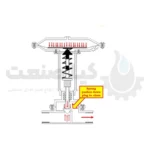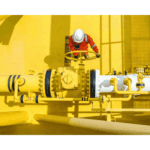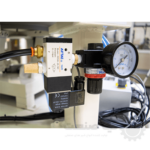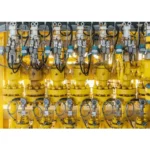Control valve sizing is the process used to determine the proper size of a control valve for a specific application.
This process involves consideration of various factors including fluid flow, pressure drop, and required control accuracy.
Effective factors in valve control sizing
The factors that should be considered when sizing the control valve are:
Fluid flow: The control valve must control the fluid flow required by the system.
To determine the required fluid flow, you must consider system characteristics, such as pipeline size, fluid type, and flow rate.
Pressure drop: Valve control causes pressure drop in the system. The pressure drop should be acceptable and should not affect the performance of other system equipment.
Control accuracy: The control valve must be able to control the fluid flow with the required accuracy. The required control accuracy depends on the specific application.
When operating in a half-open and half-closed state, control valves serve much the same purpose in process systems as resistors do in electrical circuits.
The energy loss in valve control is that the energy lost is mostly in the form of heat, although some of the energy lost appears as vibration and noise.
Valve noise can be severe in some cases, especially in some gas flow applications.
In most control valves, the dominant mechanism is energy dissipation as a result of turbulence introduced to the fluid as it moves through the constricted sections of the valve cut.
Valve control measurement principles
The act of selecting an appropriate control valve for the expected energy dissipation is called valve sizing.
A counter valve with a small size causes many problems including flow restriction (choked flow).
Where the control valve is not able to provide the required flow rate even when fully opened. Restricted flow can cause a momentary pressure drop, resulting in cavitation, a phenomenon in which the formation and subsequent bursting of bubbles causes erosion.
Another common problem is the flash valve control.
Flashing occurs when a fluid evaporates due to a drop in pressure in the constricted vein, which causes erosion.
A large valve control valve destroys control clarity compared to a properly sized control valve.
A general rule of thumb is to size the valve control to use the maximum possible range and the desired set point occurs at approximately 60% to 80% of maximum, which is the ideal process set point condition.
Control valve sizing methods
Use the chart
Different methods can be used for sizing the control valve.
One of the common methods is to use control valve sizing charts.
These charts take into account the fluid flow, pressure drop, and control accuracy required and determine the appropriate control valve size for each specific condition.
Control valve sizing software
Using valve control sizing software
Another method of valve control sizing is to use valve control design software.
These softwares consider various factors and determine the appropriate size of valve control for each specific situation.
An example of valve control sizing software is the Bray Sizing Program software, which is a powerful control valve measurement software that automatically performs valve control sizing calculations.
BII measurement software generates an ISA spec sheet based on your control valve flow requirements and can predict cavitation, noise and Cv at different orifices, ensuring accuracy in operation.
Finally, a control valve engineer can be used to assist with control valve sizing.
A valve control engineer can consider various factors and determine the right size valve control for your specific application.
Example
Suppose you have a system with a fluid flow of 100 liters per minute.
The acceptable pressure drop in the system is 10 pascal and the required control accuracy is 10%.
Control valve sizing charts can be used to determine the appropriate control valve size.
Using these diagrams, it can be seen that the correct valve control size for this situation is a 2 inch control valve.
Physics of energy dissipation in a turbulent fluid flow
Control valves are rated for their ability to reduce fluid flow in the same way that resistors are rated for their ability to inhibit the flow of electrons in a circuit.
For resistors, the unit of measurement for electron flow limitation is the ohm: 1 ohm of resistance leads to a voltage drop of 1 volt across that resistor.
Ohm’s law is a simple, linear relationship that expresses the “friction” of electric charge carriers during slow motion in a solid body.
When a fluid moves turbulently through any boundary, energy is inevitably lost in that turbulence.
The amount of wasted energy is proportional to the kinetic energy of turbulent motion, which is proportional to the square of the velocity according to the classical kinetic energy equation for moving bodies.
We know that the amount of energy lost by turbulence in such a fluid flow will be a quantity (k) of the total kinetic energy.
Any energy lost in turbulence ultimately appears as a drop in fluid pressure downstream of that turbulence.
Therefore, a control valve (control valve) that neutralizes the fluid flow.
The upstream pressure will be greater than the downstream pressure (assuming all other factors such as pipe size and height above ground downstream are the same as upstream)
For a valve control that pressurizes a fluid stream.
Only the first and last variables change with stem position, and the fluid density remains relatively constant.
In control valve engineering, it is customary to express the “restriction” of each valve in terms of the flow rate according to a certain pressure drop and the specific weight of the fluid (Gf).
Conclusion
Control valve sizing is an important process that must be done carefully. Properly sizing the control valve for a specific application ensures proper system performance.
You can contact our engineers at Kia Sanat for advice on choosing the best valve control size.
Contact us for all types of valve controls such as Samson valve control, Fisher valve control, Masonilan valve control, Honeywell valve control, Isfahan steam pneumatic valve, Samson pneumatic valve, etc.
Useful links:
20 important factors in valve control performance
Control valve packing
Valve control inspection
Important factors in choosing valve control
9 reasons for using itopi positioner








